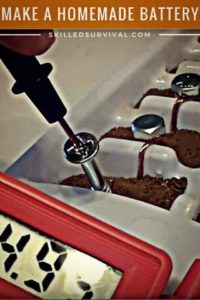Today I have something extremely important for preparedness…
A Complete Guide On How To Make A Homemade Battery
Because our electric grid is one of the most valuable (and vulnerable) resources we have.
Without the grid, millions would suffer, and society’s norms would crumble.
Life would become a challenging endeavor.
But you can offset these risks with homemade batteries…
TOPICS IN THIS ARTICLE… ↓(click to jump)
- Modern Life Without The Grid?
- The Basic Science Behind Batteries
- How To Make A Homemade Battery
- How To Recondition Old Batteries
- Survival Uses For DIY Batteries
- What About Rechargeable Batteries?
Imagine Modern Life Without The Grid
If the grid fails, people will start hoarding and using batteries like they’re going out of style.
All batteries will vanish from store shelves before you can say “turmoil.”
↓ How Long Would Society Last During a Total Grid Collapse?
Because having a battery is like carrying around a pocket generator.
And as we’re all aware, power generation is useful (no matter what form it comes in).
Batteries are used to power any number of important devices like:
- flashlights for illumination
- hot plates for cooking
- and radios for emergency communication
Unfortunately, most batteries won’t last long in a serious emergency.
They’ll become one of the first resources looted from stores.
But even if your lucky and snag a few hundred before a disaster, they’re consumable.
They won’t last forever.
Sure, high-quality batteries tend to have a longer life than cheap ones.
But we’re talking a few extra days (maybe weeks).
Not enough to make a significant difference in a prolonged disaster.
However, just because something is no longer on a shelf doesn’t mean it’s unavailable.
The electrical grid might not work, but electricity can still be generated.
It won’t be easy, and they won’t generate power like a solar powered generator or DIY generator.
But a homemade battery can store the energy generated by your solar powered generator or homemade generator.
So it’s a survival skill worth learning!
The Basics On How Batteries Work
Before building your own batteries, it’s imperative to understand the basic concepts.
And in this case, all batteries follow the same general idea:
Mix the right chemical solutions, and connect them to ‘flow’ in one direction – from negative (-) to positive (+).
Every battery has three parts: the anode (-), cathode (+), and electrolyte.
The anode and the cathode (which are the negative (-) and the positive (+) ends of a battery) connect to the electrolyte.
Chemical reactions within then start generating energy.
The energy flows from negative (-) to positive (+) around the circuit you’ve created.
The simplest battery I know of is made with a lemon, a copper piece of wire, and a piece of aluminum foil:
Stick the two metallic pieces into the lemon’s skin and connect them with a wire, and you have got a battery.
Granted, it won’t generate much voltage (you can’t run your car on lemons), but there is some energy.
This concept is the same for larger batteries; only the chemicals are more potent…
↓ How batteries work – Adam Jacobson
Want a free 78 item preppers checklist?
Enter your email below to instantly download this Complete Checklist PDF. No purchase necessary. 👇 👇How To Make A Homemade Battery
Let’s start small and build our way up.
But before we make the batteries, let’s clarify one crucial point.
The batteries we’ll be building today produce only DC (Direct Current) electricity.
As opposed to the more efficient but more complicated AC (Alternating Current) power.
DC batteries (like the ones you’ll be making) are crude vs. batteries used in engines.
They’re great for the basics like:
- lighting
- small amounts of heat
- and powering small pocket radios
But they won’t replace a car battery.
Building A Single Cell 1.5 Volt Battery
Supplies: aluminum can, copper wire/cord, water, bleach, and cup.
Cut the can along its side and, flatten it out, roll up the edge of the can into a small aluminum bar.
Fill the cup about halfway with water, add a teaspoon of bleach, and mix with a spoon.
Place the copper cord and the aluminum bar into the cup.
Make sure they’re not touching each other at the bottom.
Then connect the two with a wire.
The chemical reaction within the cup generates roughly 1.5 volts of electricity.
It will flow from the aluminum cathode (-) to the copper anode (+).
↓ Power From Trash – DIY Project
Building On That
In a sense, these little cup batteries act like Legos.
Because you can connect one aluminum cathode (-) to the next copper anode (+), you can stack eight or nine cups to make a ~12 Volt DC
Make four or five of those cells in series, and you can generate 60 Volts of DC electricity – not bad at all.
The Ice Tray Battery
Supplies: 1 ice tray, copper wire, aluminum bolts/screws, vinegar, lime juice, water
The next step is the more compact, portable Ice Tray 9 volt.
Using the same concept as above, you can pour a solution of vinegar, water, bleach, and lime juice into each ‘cube.’
Using the copper wire, make a hanging loop.
Now drape the copper wire loop and aluminum screw over the edge between each ‘cube’ on the ice tray.
Make sure that both the ends of the screw and the copper wire are submerged in the solution.
The electric flow moves from the aluminum screw cathode (-) into the electrolyte in the ‘cubes’ and into the copper wire anode (+), which receives it and passes it along to the next aluminum cathode.
Do not break this circuit!
Alternate the cathode to the anode, to the electrolyte, and the cathode.
In the same way, in a counterclockwise direction around the ice tray.
Once you have an entire circuit to carry your electricity, use two pieces of wire to connect the 9-volt battery.
If it doesn’t work right away, double-check your circuit is unbroken and flows in a single direction.
Here’s an excellent video giving an overview of how these small setups work.
↓ Homemade Battery 1.5v – 12v water powered
And here’s another ice cube tray battery but using dirt to fill the cells, “The DIY Earth Battery”:
↓ The DIY “Earth Battery”
Reconditioning Old Batteries
It may sound implausible.
It may seem unsafe. Heck, it may even sound too good to be true.
Now, this is advantageous knowledge to learn.
Why? Because homemade batteries aren’t revolutions in high electricity output.
That is to say; they’re crude and small.
An ice cube tray batteries only work well for small tasks.
Bigger batteries (i.e., car batteries) offer more power and more survival applications.
Knowing how to recondition batteries serves a lot of practical survival purposes.
And reconditioning batteries is also an environmentally sustainable practice!
Batteries are toxic and difficult to recycle.
And in our throw-away society, many of them are wasted daily by people who don’t know how to recondition them.
Still Not Convinced?
Reconditioning old batteries can also be financially beneficial too.
Many people learn how to recondition batteries, fix up old used ones, and then resell them.
Sounds great, right?!
Well, good. Because I’m about to explain how to do it.
Be warned: reconditioning old batteries is more complicated than building the simple science class contraptions in this article’s “Homemade Batteries” section.
It can also be dangerous.
I highly encourage you to invest in some safety equipment first.
Items like chemical goggles, gloves, and aprons are necessary.

Want a free 78 item preppers checklist?
Enter your email below to instantly download this Complete Checklist PDF. No purchase necessary. 👇 👇Here’s One Simple Way To Recondition An Old Car Battery
Remove the rubber tops that protect the caps.
Then, remove the caps as well – depending on what kind you’re working with, you may have to remove as many as seven caps.
But be sure to remove all entirely!
Once the caps are out, fill it with new acid.
You can easily buy acid online from reputable sources.
Or, if you need to, you can mix your own:
- Boil a ½ gallon of distilled water
- Add ½ lb. of Epsom salt
- Stir until you create salt water
Ensure the lead plates inside each cell are completely covered before replacing the cells.
Rock it back and forth for 60 seconds.
Rocking helps to ensure the mixture has coated all surfaces within both battery cells.
Plug the battery in to charge for the next 24 hours.
Ensure you’ve correctly connected the positive (+) and negative terminal (-) ends in the right places!
This process often works, but it’s more of a short-term solution.
This process won’t bring it back anywhere close to “like-new” or work for very long.
↓ How To Make Old Batteries New Again!
However, some other more technical methods and processes are more effective at restoring an old car battery.
That’s why I highly recommend consulting a professional guide before trying this yourself.
It’s Worth Getting Detailed Guidance From The Pros
So here’s a worthwhile video from a professional reconditioning expert giving some advice on the best way to get started:
↓ How To Recondition An Old Dead Battery
Here are a few more notes on refurbishing batteries:
Be extremely cautious when working with reconditioned batteries.
If done incorrectly, a car battery can become a small bomb.
If tampered with or improperly, your “reconditioned” battery might go BOOM!
Also, regularly operating vehicles on refurbished batteries can be hazardous to you and others.
It all comes back to knowing what the heck you’re doing, and you do this by investing in professional knowledge and advice.

Want a free 78 item preppers checklist?
Enter your email below to instantly download this Complete Checklist PDF. No purchase necessary. 👇 👇Survival Applications For Homemade Batteries
How useful would it be to make a homemade battery or refurbish old batteries in a world without electricity?
To be one of few who’s figured out the secret mysteries of battery making and refurbishment.
That’s the kind of power that pays off.
But it’s always good to visualize the benefits of that kind of technology.
Because in our world of flashing lights, gadgets, and computers, it’s easy to take electricity for granted.
It’s everywhere today – without it, you wouldn’t be reading this article.
Now, smaller homemade batteries are best for simple basic needs such as lighting, heat, and communication.
With a small homemade battery, you don’t need a candle; you don’t have to rely on the grid or even commercial batteries.
But you can still have consistent, flameless, odorless, chemical-free light.
Refurbished car batteries are great for a lot of things.
You can charge small devices like phones, GPS, computers, flashlights, radios, and other survival gadgets with them.
Then recharge the car battery with a small solar panel or DIY generator setup.
Refurbished car batteries can power larger appliances. Small refrigerators, televisions, surveillance systems, and the like are all on the table.
Albeit, for only a few hours, unless you daisy-chain multiple batteries to create what’s called a battery bank.
You can even get off the grid entirely with off-grid power generation and a large bank of car batteries.
Knowing you don’t need the grid at all is a fundamental self-reliant achievement.
It’s a lofty but worthwhile goal!
Everything Dies, Get Over It
The simple fact of the matter is this: Batteries don’t last forever.
Not the homemade ones, commercial ones, or those with the pink badass little bunny.
And even refurbished batteries can only be resurrected so many times.
Batteries, like all things, eventually die.
Don’t ever expect them to live forever.
That being said, it’s always best to stay prepared for when your batteries do, in fact, kick the bucket.
You’ll have to replace pieces or entire cells throughout its life.
That’s alright – it’s the small price you’ll pay for having electricity when no one else does.
And if you are reconditioning batteries, stay safe.
Never forget you’re working with electrical boxes full of acid that can (and will) explode if you mess them up too badly.
Once again, this is the price of harnessing free home-generated electricity when others do not.
The Latest In Rechargeable Technology
It might just be the world’s best survival battery.
The EasyPower USB Battery uses a simple USB connection to recharge.
Meaning, it works just as well in the office as it does in the wilderness…
And that, my friends, makes it the best AA battery for any situation on the planet!
↓ USB Rechargeable Batteries!
The Final Word
Volta made the first battery in 1800.
And since, batteries have become an integral part of life in the modern world.
They’re in our cars and trucks, phones and computers, and almost everywhere.
And for a good reason.
Portable stored electricity is one of the greatest and most versatile resources ever invented.
Knowing how to make and refurbish batteries are survival skills that aren’t very common.
They’re techniques for survivors who want to set themselves ahead of the masses.
And storing the power of electricity is one hell of a leg up.

Prepare, Adapt & Overcome,
P.s. - I just found out 2 out of 3 Americans don’t feel prepared for a 3 day disaster!!!
I guess this goes to show how modern society continues to embrace ‘living a fragile life.’ What’s crazy is… it’s so easy to fix.
To make sure YOU have the basics, watch our FREE training on “10 Simple Steps To Basic Preparedness” that shows you HOW.
Nothing crazy here… this isn’t doomsday prepping... just the basics every responsible adult should have before a disaster strikes.Why You Can Trust Skilled Survival...
Go here now to review a full breakdown of:
- Who We Are
- Our Credentials
- Our Mission
- & Product Recommendations...
Here are a few highlights of our teams credentials & certifications:
- Certified Member of a Mountain Search & Rescue Organization
- Plant Emergency & Safety Leader for a Major Food Manufacturer
- Member of the 10TH Mountain Division Hut Association
- Certifications: Avalanche 1, WFR, CPR
- Official Gear Tester for Numerous Outdoor Gear Companies
- Countless Multiday Backpacking trips into Remote Wilderness
- Bachelor's Degree In Mechanical Engineering
- Bachelor's Degree In Civil Engineering
- Bachelor's Degree In Biomedical Engineering
"It takes 20 years to build a reputation and five minutes to ruin it." - Warren Buffett
We're fully aware that trust is NOT something you GET but is EARNED.
And we'll continue to earn YOUR trust through our forthright and honest approach with each new Blog Post, Guide & Product we create...
P.s - I just took this FREE 60-second 'Readiness Score Quiz'👇
AND... I've still got a few gaps in my preps...🤔 But at least, I'm not part of 'The Fragile Masses'. 👍 Find out where YOU stand by answering a few questions...

Recommended Reading
Survival Pack: How To Build One NOW (before SHTF)
A complete list of critical items that need to be in your survival pack before heading out into the wilderness.
Survival Packing List: Best For An Evacuation
Everyone needs a survival packing list to organize their escape. That way you won't regret leaving something critical behind.
Wild Edible Plants: The 13 Best Ones ANYONE Can Find
Discover the best wild edible plants you can find and eat nearly anywere. Knowing and identifying these wild edibles could save your life.
How To Make Catfish Bait: My Grandpa’s Ultimate Recipe
I want to share with you what I consider the best catfish bait recipe. Here's how to make stink bait that will get the catfish to bite.
Paracord Projects: 17 Useful Survival Tools You Can Make Today
I share the best paracord projects that are both fun and useful. By doing these crafts you'll always have lifesaving cordage on hand.
Survival Skills: The Ones Everyone Should Master
The best survival skills will keep you alive even in extreme conditions. 1. Water 2. Shelters 3. Fire 4. Navigation 5. Signaling 6. Medical
